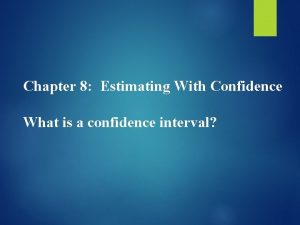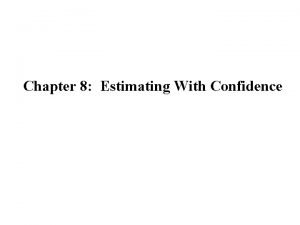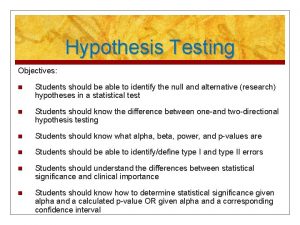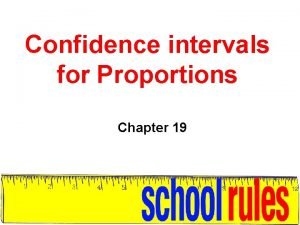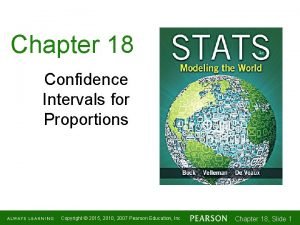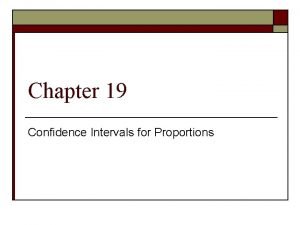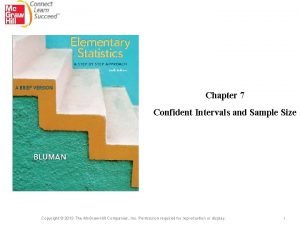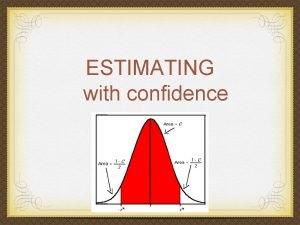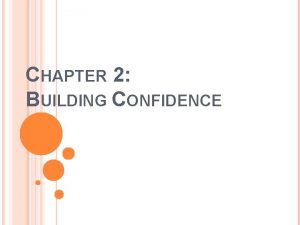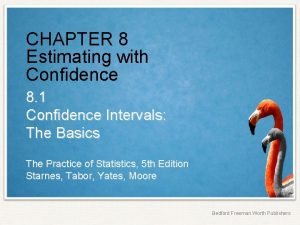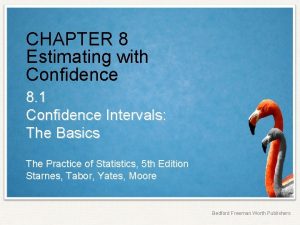CHAPTER 8 Estimating with Confidence 8 2 Estimating









- Slides: 9

CHAPTER 8 Estimating with Confidence 8. 2 Estimating a Population Proportion The Practice of Statistics, 5 th Edition Starnes, Tabor, Yates, Moore Bedford Freeman Worth Publishers

Estimating a Population Proportion Learning Objectives After this section, you should be able to: ü STATE and CHECK the Random, 10%, and Large Counts conditions for constructing a confidence interval for a population proportion. ü DETERMINE critical values for calculating a C % confidence interval for a population proportion using a table or technology. ü CONSTRUCT and INTERPRET a confidence interval for a population proportion. ü DETERMINE the sample size required to obtain a C % confidence interval for a population proportion with a specified margin of error. The Practice of Statistics, 5 th Edition 2

Activity: The Beads Your teacher has a container full of different colored beads. Your goal is to estimate the actual proportion of red beads in the container. ü Form teams of 3 or 4 students. ü Determine how to use a cup to get a simple random sample of beads from the container. ü Each team is to collect one SRS of beads. ü Determine a point estimate for the unknown population proportion. ü Find a 95% confidence interval for the parameter p. Consider any conditions that are required for the methods you use. ü Compare your results with the other teams in the class. The Practice of Statistics, 5 th Edition 3

Conditions for Estimating p Suppose one SRS of beads resulted in 107 red beads and 144 beads of another color. The point estimate for the unknown proportion p of red beads in the population would be How can we use this information to find a confidence interval for p? The Practice of Statistics, 5 th Edition 4

Conditions for Estimating p Before constructing a confidence interval for p, you should check some important conditions Conditions for Constructing a Confidence Interval About a Proportion • Random: The data come from a well-designed random sample or randomized experiment. o 10%: When sampling without replacement, check that • Large Counts: Both The Practice of Statistics, 5 th Edition are at least 10. 5

Constructing a Confidence Interval for p We can use the general formula from Section 8. 1 to construct a confidence interval for an unknown population proportion p: When the standard deviation of a statistic is estimated from data, the results is called the standard error of the statistic. The Practice of Statistics, 5 th Edition 6

Finding a Critical Value How do we find the critical value for our confidence interval? If the Large Counts condition is met, we can use a Normal curve. To find a level C confidence interval, we need to catch the central area C under the standard Normal curve. To find a 95% confidence interval, we use a critical value of 2 based on the 68 -95 -99. 7 rule. Using Table A or a calculator, we can get a more accurate critical value. Note, the critical value z* is actually 1. 96 for a 95% confidence level. The Practice of Statistics, 5 th Edition 7

Example: Finding a Critical Value Use Table A to find the critical value z* for an 80% confidence interval. Assume that the Large Counts condition is met. Since we want to capture the central 80% of the standard Normal distribution, we leave out 20%, or 10% in each tail. Search Table A to find the point z* with area 0. 1 to its left. The closest entry is z = – 1. 28. z . 07 . 08 . 09 – 1. 3 . 0853 . 0838 . 0823 – 1. 2 . 1020 . 1003 . 0985 – 1. 1 . 1210 . 1190 . 1170 So, the critical value z* for an 80% confidence interval is z* = 1. 28. The Practice of Statistics, 5 th Edition 8

Estimating a Population Proportion Section Summary In this section, we learned how to… ü STATE and CHECK the Random, 10%, and Large Counts conditions for constructing a confidence interval for a population proportion. ü DETERMINE critical values for calculating a C % confidence interval for a population proportion using a table or technology. ü CONSTRUCT and INTERPRET a confidence interval for a population proportion. ü DETERMINE the sample size required to obtain a C % confidence interval for a population proportion with a specified margin of error. The Practice of Statistics, 5 th Edition 9
 Chapter 8 estimating with confidence
Chapter 8 estimating with confidence Chapter 8 estimating with confidence
Chapter 8 estimating with confidence Chapter 8 estimating with confidence
Chapter 8 estimating with confidence Confidence interval vs confidence level
Confidence interval vs confidence level Confidence interval vs confidence level
Confidence interval vs confidence level Critical value for 90 confidence interval
Critical value for 90 confidence interval Chapter 18 confidence intervals for proportions
Chapter 18 confidence intervals for proportions Chapter 19: confidence intervals for proportions
Chapter 19: confidence intervals for proportions Planks of confidence
Planks of confidence Chapter 7 confidence intervals and sample size
Chapter 7 confidence intervals and sample size
